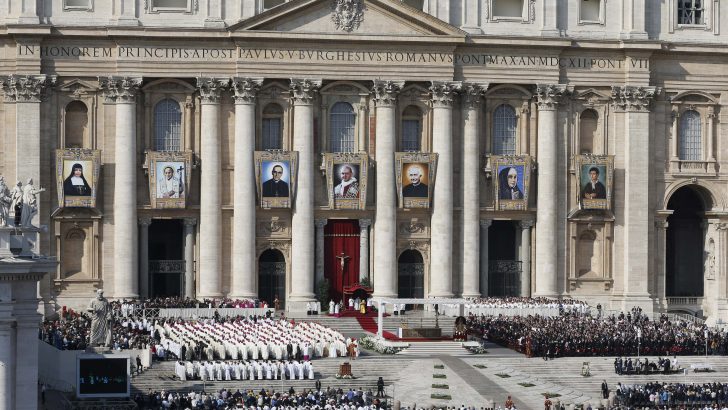About 70,000 pilgrims from around the world swarmed down Via della Conciliazione towards Vatican city, filling St Peter’s Square in a flurry of colour, waving caps and flags associated mainly with one of the seven people about to be recognised as saints.
Safe to say, with a huge turn-out from El Salvador, St Oscar Romero was the name on many people’s lips. The martyred Archbishop of San Salvador drew crowds of thousands of Salvadorans, many of whom came in large pilgrim groups to attend a canonisation they had long been waiting for.
Assassinated while saying Mass, Romero is revered for speaking out against an oppressive military government despite serious threats against his own life. The 25°C sun did nothing to quell the spirits of pilgrims who erupted into applause when the canonisations were officially announced.
Held on October 15, the canonisation ceremony took place as the Synod of Bishops on ‘Young People, the Faith and Vocational Discernment’ was at the halfway mark – it will run until October 23. It was the largest canonisation ceremony to take place since the Pope declared St Pope John XXIII and St John Paul II saints in April 2014.
Inspiration
The CEO of Trócaire, Caoimhe de Barra, who attended the canonisation, told The Irish Catholic that St Romero has long been an “inspiration” for human rights workers and his canonisation is a “realisation of a dream” for many.
She told this paper: “He was an extraordinary man in that when he started his life he wasn’t someone who was terribly radical or outspoken…when he became the Archbishop of San Salvador he realised by talking to ordinary people what was happening: the disappearances, the deaths, the executions, the death threats – and then his own very good friend, a Jesuit priest, was murdered – he became immediately aware then that the voice of the Church had to be extremely strong on social justice, on Gospel values and on human rights.”
Trócaire funded St Romero’s commission for justice and peace when he was the Archbishop of San Salvador, they funded his legal justice work – which was legal work in the defence of the rights of people who had been targeted by the military government – and supported work helping women whose partners had been ‘disappeared’ or executed.
One of Trócaire’s most important supports was funding St Romero’s radio station which he used to empower the people of El Salvador and inform them of their human rights and the abuses committed by the military government. Many of the population would have been illiterate or wouldn’t have access to newspapers or televisions, so radio was one of the few ways for mass communication.
“He knew that he was taking a huge chance as well, that his life was essentially at very high risk so for the three subsequent years after 1977 when his priest friend was murdered then he spent every day knowing that he was potentially at risk of being killed as well and he was receiving death threats all the time,” Ms De Barra said.
“I’ve lived with posters of Oscar Romero for almost my entire life with some of his key sayings. The one that I love is ‘aspire not to have more but to be more’. These things are very much part of who we are as Trócaire.”
St Paul VI
St Paul VI has always been an important figure for Pope Francis. He is renowned for overseeing the Second Vatican Council after St Pope John XXIII died, launching the synodal process and carrying out many liturgical changes after Vatican II.
He travelled to all five continents and was the first Pope to leave Italy since 1809. But it was Paul’s 1968 encyclical Humanae Vitae that marked his papacy, reaffirming the Church’s opposition to artificial contraception.
In his homily on the day, Pope Francis said of Paul VI: “Today he still urges us, together with the Council whose wise helmsman he was, to live our common vocation: the universal call to holiness.”
Francis also long believed Oscar Romero worthy of being recognised as a saint saying that he “left the security of the world, even his own safety, in order to give his life according to the Gospel, close to the poor and to his people, with a heart drawn to Jesus and his brothers and sisters”.
“Let us ask ourselves where we are in our story of love with God. Do we content ourselves with a few commandments or do we follow Jesus as lovers, really prepared to leave behind something for him?” the Pope asked.
He stressed the importance of leaving things behind for “love of the Lord”, be it wealth, yearning for status or power, or structures that are no longer adequate for proclaiming the Gospel.
“Today Jesus invites us to return to the source of joy, which is the encounter with him, the courageous choice to risk everything to follow him, the satisfaction of leaving something behind in order to embrace his way,” he said.
“The saints have travelled this path.”
Holiness
In his call for holiness, seen in his exhortation Gaudete et Exsultate, he stressed it is not an unobtainable ideal that belongs to the past. Both Romero and Paul VI would still be known personally by people alive today, which is rare for canonised saints.
The two saints however, both endured strong opposition within the Church in life and after death.
Of Paul VI, Francis said: “Even in the midst of tiredness and misunderstanding, Paul VI bore witness in a passionate way to the beauty and the joy of following Christ totally.”
Pope Francis has declared more people saints than any other Pope during a single papacy, with a record of 838 canonisations; this figure makes more sense when considering the canonisations of 813 of the Martyrs of Otranto.
The Otrantins were said to have been executed for refusing to convert to Islam when the city fell to an Ottoman force.
This is almost double the previous record set by St John Paul II, who canonised 482 people. Francis has also approved 755 beatifications.
The formal relics of the saints, present in reliquaries with a red-wax seal, were set at the feet of a statue of Mary during the Mass.
Most were ‘first-class’ relics: a piece of the actual physical remains of the saint.
But Pope Francis himself used other items that previously had been used by two of the new saints: he carried in procession the crosier of St Paul VI and wore his pallium; he also wore the blood-stained cincture, a rope belt, that St Romero was wearing when he was assassinated while celebrating Mass in 1980.
And for the Eucharist, he used a chalice that had belonged to St Paul VI.
The formal reliquary for St Paul VI was a glass vase containing the blood-specked undershirt he was wearing in November 1970 when a Bolivian artist stabbed him at Manila airport.
The contents of the other reliquaries were:
- St Romero: a bone fragment.
- St Francesco Spinelli: a bone from his foot.
- St Vincenzo Romano: a vertebra.
- St Nunzio Sulprizio: a bone fragment from his finger.
- St Catherine Kasper: a bone fragment from her back.
- St Nazaria Ignacia March Mesa: a lock of her hair.


 Chai Brady
Chai Brady St Peter's Basilica
St Peter's Basilica 